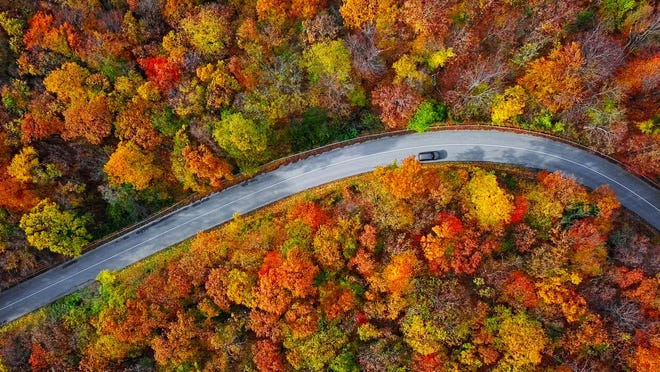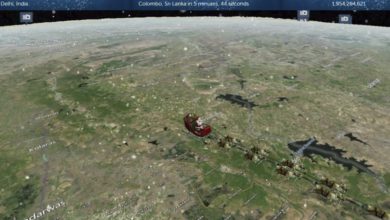
Autumn is upon us, and that might mean the leaves in your yard are starting to change color and fall to the ground.
But if you were planning to add raking the yard and bagging up leaves to your weekend to-do list, think again. Experts say raking and removing leaves can be bad for your lawn – and for the planet, too.
Leaving at least some of the leaves in your yard can help fertilize your grass, provide shelter for animals and even reduce emissions from landfills. Here's what you need to know about managing the leaves on your lawn this fall.
How can leaves help my lawn?
Fallen leaves on your lawn can serve as a natural fertilizer, David Mizejewski, a naturalist at the National Wildlife Federation, explained to USA TODAY.
“The leaves fall around the root zone of these plants, where they do things like suppress weeds or other plants from growing that that would otherwise compete with the trees and the shrubs,” he said.
“They slowly break down and compost right there at the base of the of the tree of the shrub, right above its root zone, where they return nutrients that the plant can then recycle and reuse next spring,” he said.
And mowing your lawn can break up leaves and bring nutrients to your grass, according to Maxim Schlossberg, an associate professor of turfgrass nutrition and soil fertility at Penn State.
“Since they’re smaller, they're more rapidly dismantled and decomposed by microorganisms. And the whole recycling process of those nutrients being returned to the soil occurs more rapidly,” he said.
Why shouldn’t I bag up leaves?
If you usually rake fallen leaves in your yard, put them in bags and then throw them away, you might want to think again this autumn.
According to data from the U.S. Environmental Protection Agency, in 2018, landfills received approximately 10.5 million tons of yard trimmings, which includes leaves.
Mizejewski explained that leaves and other organic matter sent to landfills can break down and form methane, a greenhouse gas that contributes to climate change.
“At this time of year, unfortunately, a huge volume of leaves just go sit in those landfills and produce all this terrible greenhouse gas,” he said. “The more we can keep that organic material out of the landfill, the better."
Seasons:The autumnal equinox marks the end of summer. But is it the start of fall or autumn?
Droughts, heat waves and more:Why climate change is making it harder for leaf peepers to chase fall foliage
How do my leaves affect the local environment?
The layer of leaves on your lawn is “really important wildlife habitat,” according to Mizejewski, forming “an entire ecosystem in and of itself.”
“There are probably thousands of different species that actually live in that leaf layer,” he said. "Most of them are invertebrates, so think of everything from earthworms and little pillbugs and all sorts of little critters that live in that leaf layer. But also higher up the food chain, salamanders, toads, box turtles, shrews and chipmunks”
Caterpillars also often find a home in leaf layers, which provides food for birds.
“So what happens if you get rid of every last leaf on your property? You’ve just swept away and bagged up and thrown into the landfill the food source that the birds are going to need to feed their babies,” Mizejewski said.
Schlossberg also warned that, if you were planning to blow leaves from your yard into the street, that can disrupt drains and local waters.
“When you have foreign debris, they can clog the grates, and that can prevent water from moving off of the surface of the street,” he said.
Leaves can also end up in streams and rivers where drains lead. That can affect the water quality and “sensitive species adapted to those waterways,” according to Schlossberg.
“It’s a little bit like a trash dump, if you will, even though it’s natural organic material,” he said. “It still persists and can be problematic.”
So can I ever rake up leaves?
If the leaves on your lawn are forming a mat over your grass, experts agree that you can move them as the weather cools across the country.
Mizejewski recommended placing leaves in garden beds or raking them into a bigger pile and letting them “naturally compost there and break down.”
“Don’t get rid of every last single leaf that falls onto your property, if you can. There’s great, easy things to do with them,” he said.
Schlossberg urged people to rake up leaves or break them up with a lawnmower if you're expecting snow soon.
"Once there’s snow, you’re not going to mow, and that snow is really going to facilitate that matting, and that coverage is going to prevent the leaves from being displaced by winds. That’s the situation you really want to avoid," he said.
But whatever you plan to do with the leaves on your lawn, experts say to consider the plants and animals in your yard and the environment at large.
“We each have an opportunity to do to take this personal action and think about how our own little piece of the earth, our own yards or our own gardens in our neighborhoods or communities, are all opportunities for us to do something good for nature,” Mizejewski said.
Source link








